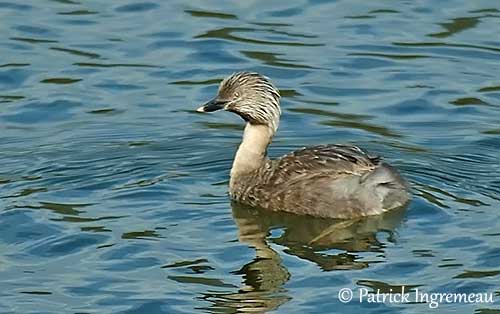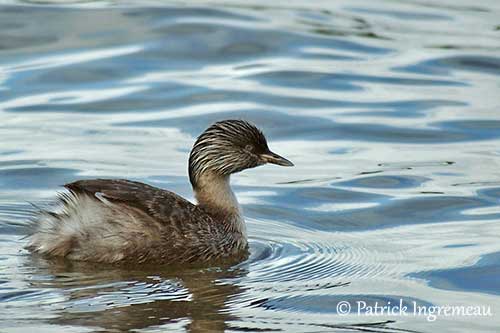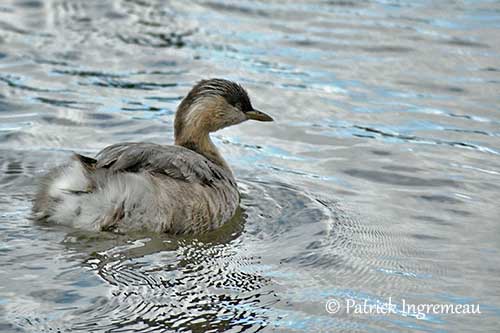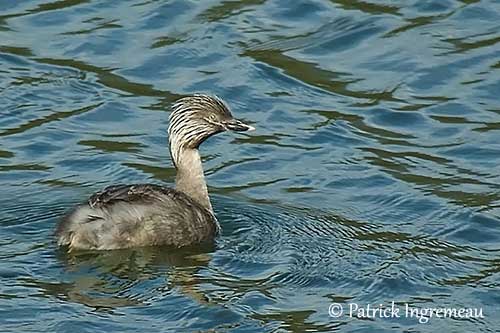
Fr: Grèbe argenté
Ang: Hoary-headed Grebe
All: Haarschopftaucher
Esp: Zampullín Canoso
Ita: Svasso canuto
Nd: Grijskopfuut
Sd: gråhuvad dopping
Photographer:
Patrick Ingremeau
TAMANDUA
Text by Nicole Bouglouan
Sources:
HANDBOOK OF THE BIRDS OF THE WORLD vol 1 by Josep del Hoyo-Andrew Elliot-Jordi Sargatal - Lynx Edicions - ISBN: 8487334105
Field Guide to Australian Birds by Michael Morcombe - Editeur: Steve Parish Publishing Pty Ltd – ISBN-10: 187628210X -ISBN-13: 978-1876282103 - 448 pages
The Graham Pizzey & Frank Knight Field Guide to the Birds of Australia - Publisher: HarperCollins Publishers (Australia) Pty Ltd; Reprint. Edition (1996) - ISBN-10: 020718013X - ISBN-13: 978-0207180132 - 528 pages
BIRDS OF AUSTRALIA by Peter Rowland – Ed: Louise Egerton - ISBN: 1864363436
Birds of Kangaroo Island: A Photographic Field Guide De Chris Baxter – Editeur: ISD LLC, 2015 – ISBN: 1921511214, 9781921511219 – 577 pages
Wikipedia, the free encyclopaedia
Hoary-headed Grebe
Poliocephalus poliocephalus
Podicipediformes Order – Podicipedidae Family
INTRODUCTION:
The Hoary-headed Grebe is found throughout Australia and Tasmania where it frequents open, fresh or brackish waters. It feeds on aquatic invertebrates and various insects caught after diving underwater to explore the bottom. This species is very gregarious and it is often seen in groups and large flocks.
This species is a colonial nester with nests about a metre apart. But it may also nest solitary. The nest is a typical floating platform attached to the submerged vegetation in well vegetated wetlands.
The Hoary-headed Grebe is described as common to abundant throughout the range. The population is suspected to be stable, but fluctuations of water levels may affect the species. But currently, it is not globally threatened.

DESCRIPTION OF THE BIRD:
Biometrics:
Length: 27-30 cm
Weight: 220-260 g
The Hoary-headed Grebe in breeding plumage has brownish-grey nape, wings and upperparts. The wings show a white trailing edge on secondaries and inner primaries, whereas the outer primaries are blackish.
On the dull buff to fawn-brown underparts, the underwing-coverts are white. The chin is paler but the flanks are darker. The belly is creamy-white with a fluffy rear.
On the brown-grey head, several narrow, long, silvery feathers are present on both head and face, giving a “hairy” appearance. A narrow, white line extends from the base of the lower mandible to below the eye, and sometimes reaching anterior ear-coverts.
The bill is blackish with whitish tip. The eyes show narrow, pale yellowish inner and outer rings, while the iris is grey with blackish glitter. Legs and lobbed feet are olive to dark grey.
Male and female have similar plumage, but the male is slightly larger with longer bill.
The non-breeding adult is very similar to breeding but the silvery hair-like feathers are much reduced. It resembles non-breeding Australasian Grebe. The dark crown extends below the eye. Face and neck are pale buff.
The juvenile resembles non-breeding adult, but it has dark stripes on the whitish lower face, and a broad, white supercilium.

Non-breeding adult on the foreground
Breeding adult in the background
RANGE:
The Hoary-headed Grebe is found in Australia (but it is rarer in C Australia), and in Tasmania. It is sometimes vagrant to New Zealand.
HABITAT:
The Hoary-headed Grebe frequents permanent or semi-permanent open wetlands, and also temporary wet areas occurring after heavy rains. It is usually more common on large bodies of freshwater, although it also frequents brackish and salt swamps.
During winter, it can be found on saline or brackish waters in bays, estuaries, creeks and inlets. It tends to avoid the waters with extensive cover of weeds.
However, during the breeding season, it prefers wetlands with abundant aquatic vegetation for nesting.
CALLS AND SONGS: SOUNDS BY XENO-CANTO
The Hoary-headed Grebe is mostly silent. During the breeding season, and especially in courtship displays, it gives a very muted churring and low, rolling, guttural sounds, also heard at the nest. These sounds are audible only over a very short distance.

BEHAVIOUR IN THE WILD:
The Hoary-headed Grebe feeds on small aquatic and marine invertebrates, insects and larvae, crustaceans, molluscs, occasionally small fish, aquatic plants and their seeds.
It feeds by diving deeply during about 15-17 seconds, during which it explores small patches of the bottom by pecking almost continuously. But in poor lighting, it forages mainly on water surface. It swims with partly submerged head and neck.
As this species takes only some small fish, it is suspected to ingest feathers less regularly than other grebes.
The Hoary-headed Grebe is gregarious and may form large flocks of up to 1,000 individuals. They often gather on open water where they form loose rafts to roost.
This species nests in colonies or solitary. The pair-bond is not permanent and the pair produces a single brood per season.
The Hoary-headed Grebe performs some movements to coastal areas where the birds gather in bays and estuaries, and also on inland lakes. In the most arid parts of the range, the species is usually highly dispersive following water levels.
Some individuals perform longer distances (up to 572 km) to reach remote lakes, and recently New Zealand between 1975 and 2014.
The Hoary-headed Grebe tends to fly when alarmed, after a long, splashing take-off from water surface. It does not allow a close approach and takes the air in a rapid flight.
It is able to fly over long distances, despite having fairly weak wings.

REPRODUCTION OF THIS SPECIES:
The breeding season takes place after the rains and often varies from year to year. It usually occurs between October and January in S of the range, but it is variable elsewhere.
The Hoary-headed Grebe is colonial to semi-colonial nester, with up to 400 nests a metre apart. The colonies are established in wetlands with abundant vegetation. But it may also nest solitary.
The nest is a small floating platform made of algae and aquatic plants. This structure is loosely anchored to the submerged vegetation, usually some distance from the shore among sparse reeds.
The female lays 3-5 white eggs that become quickly stained brown. The incubation lasts 20-25 days, shared by both adults.
The chicks have pale brown down with blackish stripes above, whereas the underparts are paler. The fledging period is currently unknown.
PROTECTION / THREATS / STATUS:
The Hoary-headed Grebe is usually common to abundant in suitable habitats, but it is rarer in drier areas.
It is vulnerable to fluctuations of water levels, but it is dispersive and usually reaches artificial water bodies such as reservoirs and dams. In coastal waters, oil spills may become a threat for these grebes.
The population size is unknown, and it is suspected to be fluctuating following water levels.
But the Hoary-headed Grebe is not globally threatened, and currently evaluated as Least Concern.
